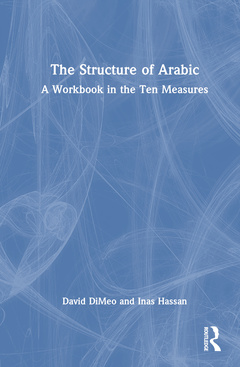The Structure of Arabic A Workbook in the Ten Measures
Auteurs : DiMeo David, Hassan Inas

The Structure of Arabic: A Workbook in the Ten Measures is a comprehensive guide and workbook in the ten measures of Arabic words, the backbone of the Arabic lexical system, and provides a systematic explanation of the root and pattern system that forms the basis of most Arabic words.
Successful Arabic learners have long recognized mastery of these measures and patterns as key to understand the Arabic language. With knowledge of this system, learners will be able to predict the meaning of unfamiliar words, recognize the function of words, and understand correct pronunciation of Arabic words, making vocabulary acquisition and retention easier. This unique textbook introduces measures and patterns sequentially across ten chapters, helping learners to navigate the topics in a logical manner. Without complicated jargon or technical language, this easy-to-understand textbook demystifies key topics in Arabic grammar. Comparative sentences which encapsulate the differences between measures give context, and exercises within the chapters serve to consolidate the learners? grasp of the material presented.
Designed to supplement both class-based Arabic courses and independent study, The Structure of Arabic will help learners of Arabic at all levels of competency to improve their vocabulary, pronunciation, spelling, and comprehension.
Introduction
Chapter One. Introduction to Roots
Chapter Two. Overview of the Measures System
Chapter Three. Measure I – فَعَلَ
Chapter Four. Measure II – فَعَّلَ
Chapter Five. Measure III – فَاعَلَ
Chapter Six. Measures V and VI – تَفَعَّلَ and تَفَاعَلَ
Chapter Seven. Measure VII – اِنْفَعَلَ
Chapter Eight. Measure VIII – اِفْتَعَلَ
Chapter Nine. Measure X – اِسْتَفْعَلَ
Chapter Ten. Measure IV – أَفْعَلَ
Appendix A. Jussive and Subjunctive Moods
Appendix B. Command (Imperative) Forms
Appendix C. The Passive Voice
Appendix D. Measure IX – اِفَعَلَّ
Appendix E. Measures Overview Chart
David DiMeo is a retired Associate Professor and Director of the Arabic program at Western Kentucky University, USA. He has taught Arabic for over 20 years. He received a Ph.D. from Harvard University and M.A. from Princeton University. He is the author of Committed to Disillusion: Activist Writers in Egypt from the 1950s to the 1980s, Taha Hussein’s The Days: A Guided Study for Arabic Learners, co-author (with Inas Hassan) of The Travels of Ibn Battuta: A Guided Arabic Reader and From Ibn Sina to Sindbad: A Guided Reader to Classics of Arabic Literature, and hosts the podcast The Golden Age of Islam.
Inas Hassan holds a Ph.D. and an MA in linguistics and Arabic grammar from Alexandria University in Egypt. She is a Teaching Professor and Coordinator of Arabic program at Loyola University Maryland, USA. She is the co-author of the books entitled The Travels of Ibn Battuta: A Guided Arabic Reader, From Ibn Sina to Sindbad: A Guided Reader to Classics of Arabic Literature, and the author of The Arabyola Portal: Integrating Trusted Arabic e-Resources into Curriculum, in The Arabic Classroom:Context, Text and Learners.
Date de parution : 07-2024
15.6x23.4 cm



